Recent Updates
09/18/2024 12:00 AM
Enjoy free access to the Autocar Archive
09/17/2024 12:00 PM
Lotus shows sports car future with wild Esprit-inspired three-seater
09/17/2024 12:00 PM
Esprit de War: When Lotus' GT2 racer met its road-going sibling
09/17/2024 12:00 PM
Car makers extend life of combustion engines amid EV hangover
09/17/2024 12:00 AM
Brazilian EREV first to use engine from Renault-Geely firm Horse
09/17/2024 12:00 AM
Mystery Audi test car hints at extreme electric 4x4
09/16/2024 12:00 PM
Kia plots Picanto, Stinger GT successors to bookend EV line-up
09/16/2024 12:00 PM
Renault Estafette reborn as futuristic van for cities
09/16/2024 12:00 PM
Big electric myths, busted by Audi e-tron
09/15/2024 12:00 PM
Rising star: we go for a ride in Polestar's new electric boat
EV, Hybrid, Hydrogen, Solar & more 21st century mobility!
 With great range, low running costs and a fast-growing UK charging network, running an all-electric car is easier than ever
With great range, low running costs and a fast-growing UK charging network, running an all-electric car is easier than ever
If you’ve been thinking about making the switch to an all-electric car but you’re worried about whether right now is the right time, you’re probably not alone.
There are plenty of myths and misconceptions around electric cars – especially the topics of range anxiety, poor charging infrastructure and running costs. So, despite the fact that much of the negative press is outdated, unfounded or easily disproven, it’s natural to pick up on the vibe of the naysayers and have a few concerns.
But you only need to look at how the latest wave of all-electric models are changing the conversation – and that’s particularly true of the fast-growing Audi e-tron range.Â
With impressive range[1], ultra-rapid charging capability[2], and advanced always-online navigation and connectivity that makes it all easy[3], all-electric models like the Audi Q4 e-tron, the Audi Q6 e-tron and the Audi Q8 e-tron are making the switch simple, hassle-free and – if anything – even more joyous than sticking with petrol and diesel.
So, as well as examining some of the more unusual myths around electric driving, we’ve examined some of the biggest electric myths in order to prove why they’re so wrong, and how the Audi e-tron range has the ultimate answer. Read on to find out more...
Learn more about the Audi e-tron range
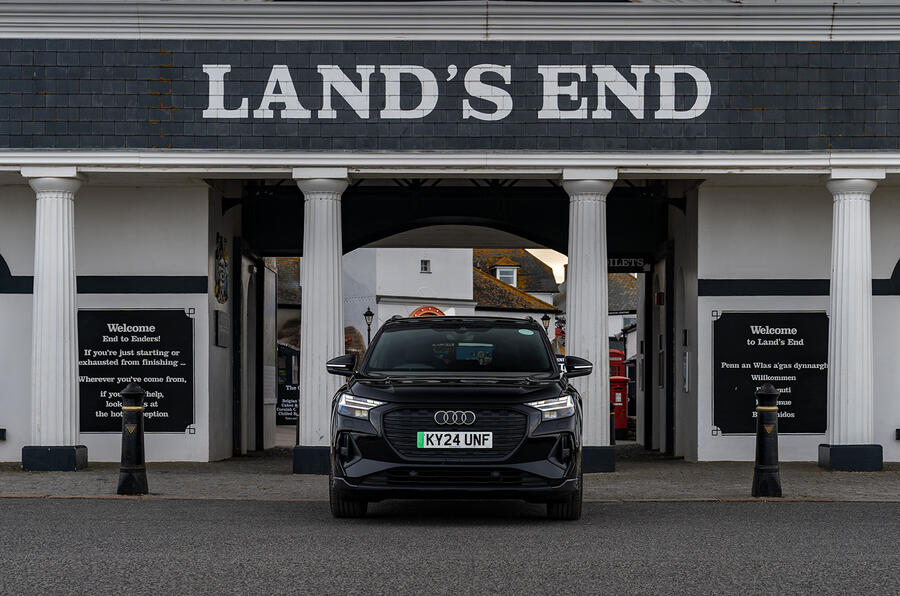
Myth #1: Electric cars don’t have enough range
Let’s start with the big one: the heavily outdated perception of ‘range anxiety’ that unfortunately still lingers today. That’s despite the fact that the latest generation of all-electric cars have more than enough range for most daily journeys.Â
Equally, range is often misunderstood. It’s not how much you’ve got; it’s how you actually use it in the real world. Let’s take some typical average UK mileage figures.Â
According to UK Government statistics[2], we’ve been driving a lot less in recent years, so the average mileage of a UK driver has dropped from 7,400 miles a year or 20 miles a day in 2019 to just 6,600 miles a year or just 18 miles a day in 2022. Even if you take a higher-mileage company car driver doing 13,000 miles a year, that’s only 36 miles a day on average. So, most journeys are around 20-40 miles at most.
Depending on which Audi e-tron model you pick, according to official WLTP test data the Audi Q4 e-tron offers up to 328 miles of range on a full charge, while the Audi Q8 e-tron boasts up to 343 miles of range, and the Audi Q6 e-tron delivers up to 381 miles of range.[1]Â
So, presuming that the typical range of a UK driver is 20-40 miles a day for a mix of daily commutes, shopping trips, school runs, and weekend days out, that means the Audi Q4 e-tron, Audi Q6 e-tron or Audi Q8 e-tron are all capable of doing up to a week of typical journeys (and possibly more) without even needing to be plugged in.
Add in the fact that most journeys either start or finish at home or at work where you may be able to plug-in to add to your battery’s range – or can incorporate some form of public top-up charging into your journey – and you can see how, with just a little bit of planning, it’s unlikely that you’ll run out of range.
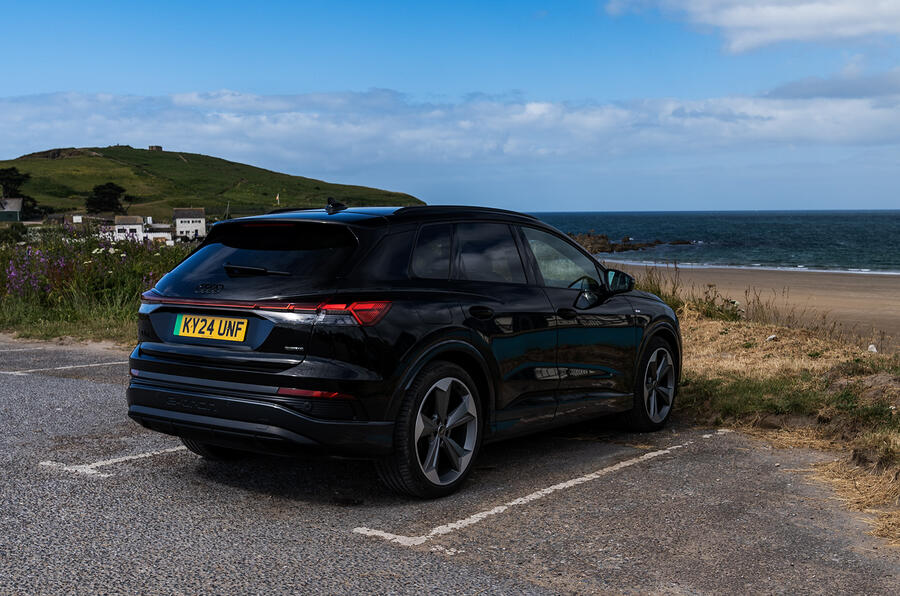
Myth #2: Electric cars can’t do long journeys
So, it’s clear that we drive less than we think. But it’s the extreme scenarios – the big journeys – that scare us the most. It’s what’s called ‘range anxiety’: the fear that we’ll be nervously watching our in-car display and getting paranoid about running out before we reach our destination or having to waste time finding and using a charger.
Well, as we’ve seen, with a fully charged battery the latest breed of Audi’s e-tron models offer some impressive figures for overall range according to official WLTP test data. But let’s put that into context for long journeys.
Take a trip from London to Leeds. That’s a drive of approximately 196 miles – well within the maximum 328-mile range of the Audi Q4 e-tron[1] and will within the 263-mile range of even the high-performance Audi SQ8 e-tron.[1] Equally, London to Leeds is a journey that would take four hours, and you wouldn’t typically do that without stopping for a coffee or lunch, giving you enough time to top up with a healthy dose of range on an ultra-rapid charger.[2]
Myth #3: There aren’t enough public chargers
So, we’ve established that the latest breed of electric cars has more than enough range for most journeys, big and small. And, as most journeys start from a home or an office where there’s often an established opportunity to charge, all you need to consider is how and where you can charge away from home.Â
And that brings us to the other side of ‘range anxiety’, which is often better described as ‘charging anxiety’. So, what’s the truth on charging points?Â
Well, according to zapmap.com, as of April 2024 there were 61,232 electric vehicle charging points across the UK at 32,697 charging locations.[5] That’s a 45% increase over the previous year, and it’s predicted we’ll reach 100,000 points by August 2025.[6]
To put that in another perspective, there are currently just over 1m electric cars currently on the road in the UK[7] – which means that there is around one charging point for every 17 cars. But, as the critics say, not all chargers are equal. Some chargers are fast[2] and some are slow. So, let’s talk charging speed…
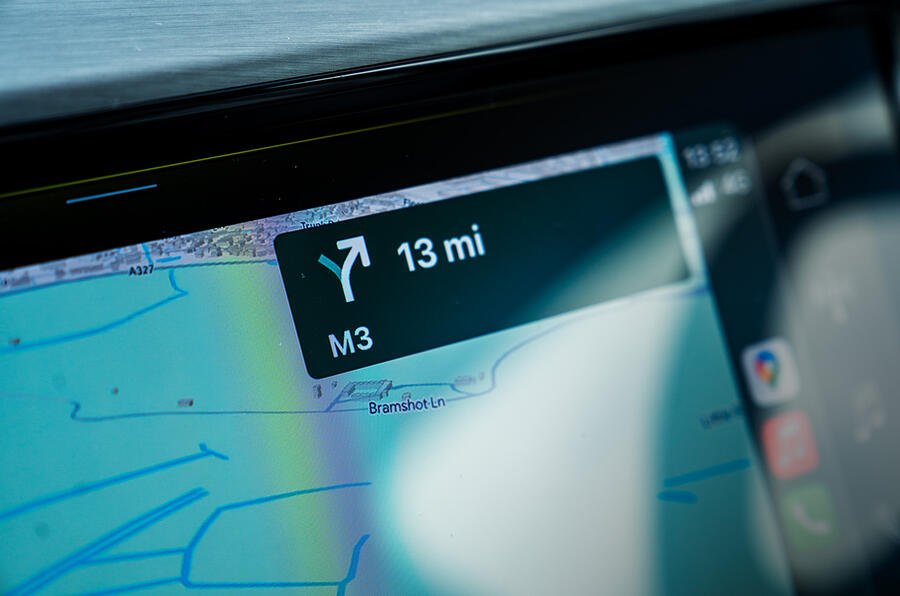
Myth #4: Electric charging takes too long
Let’s get this out of the way: swapping to electric charging after a lifetime used to brimming a petrol or diesel tank to full in just a few minutes is absolutely a bit of a culture shock – and charging an electric car at a public charger will certainly take longer than filling up a petrol or diesel car at the pump. Â
You’d be surprised, though, just how quickly a modern all-electric car can use the right sort of charger to top up a big dose of miles, and – if you tweak your thinking – just how little time you need to spend charging.
Let’s start with charging speeds. Pick an Audi Q4 e-tron with its 175kW charging speed capability, and you could top its battery up from 10% to 80% in as little as 28 minutes[8] using a 175kW+ ultra-rapid charger.[2] The Audi Q6 e-tron boasts next-generation 800V technology with charging speeds up to 270kW, which can top you up from 10% to 80% in as little as 21 minutes[8] using a 270kW+ ultra-rapid charger.[2]Â
So, you can easily get a healthy dose of miles in less time than it takes to grab lunch. But do you really need to spend that long charging? Why not just top up the miles you need on a public charger to get to slightly slower, but more cost-effective charging at your journey’s end? This is something that EV advocates call ‘grazing’ for charge on-the-move, before finding a ‘destination’ charger at your final halt.
There are two good reasons for this: ultra-rapid public chargers are among the most expensive in the UK network, with pay-as-you-go rates of around 74p per kWh.[9] Equally, the charging curves of Audi’s advanced e-tron batteries are designed to charge fastest at low capacities of 10% to 20% before slowing down the charging rate at the top of the curve from 80% to 100%.
So, there’s little point in waiting – and paying a premium – to charge past 80%, when you can just top up the miles you need and get on your way to a more convenient, time-efficient and cost-effective overnight charging point at your destination. It also helps you preserve the long-term performance of your car’s battery.
This is where the advanced connected[3] electric-focused navigation in Audi e-tron models comes in. Whether you’re using the myAudi smartphone app[10] to plan your route in advance from the comfort of your sofa, or using the in-car Audi Connect infotainment system on-the-go[3], it lets you find appropriate charging options for your journey – whether it’s ultra-rapid charging[2] on or near your route for a quick top-up, or slower more cost-effective charging with long-term parking near your destination.

Myth #5: There aren’t enough ultra-rapid chargers
Let’s start with the facts. There are currently around 4,988 ultra-rapid chargers in the UK with speeds greater than 150kW, forming 8% of the network, while the 6,936 rapid chargers with charging rates of 50kW to 149kW make up another 11%.[5] So, fast chargers are still in the minority in the network, but the network is also adapting – and the numbers of these types of chargers is growing fast.
Even more crucially, where these rapid and ultra-rapid chargers have been placed is more important.[5] You’re more likely to find them at motorway service stations or at large petrol stations close to main A-roads, as that’s where the highest demand for ultra-rapid charging will be. So, if you do need a rapid or ultra-rapid charger, you’ll likely be able to find the right option on a long journey on a motorway or A-road.
But not all charging needs to be ultra-rapid. In fact, lots of rapid charging can potentially damage your battery. So, if you’re away from home and can do a longer top-up charge, that’s where the other 81% of the network comes in. These 8kW to 49kW chargers are often called ‘destination’ chargers as they’re located at the sort places where you’d spend a longer extended amount of time – such as city centre car parks, hotel car parks, supermarkets, retail parks and leisure centres.Â
These destination chargers offer you a convenient place to plug in and top-up at slower more cost-effective rates while you’re doing longer activities such as parking your car up overnight, doing some shopping, having a work meeting, relaxing over a long meal, taking in a film, or doing a session at the gym.
Myth #6: Public chargers aren’t reliableÂ
This is one of the areas where there’s some good news. The UK Government’s Public Charge Point Regulations of 2023[11] means that charge point operators need to meet a reliability requirement, where public charge points of 50kW and above should be available (on average) 99% of the time. The provider must also offer a free telephone helpline that’s staffed 24/7 and advertised at all charge points. So, you should find a public charge point that’s working when you need it. But, if you can’t, you can call someone to ask for support.
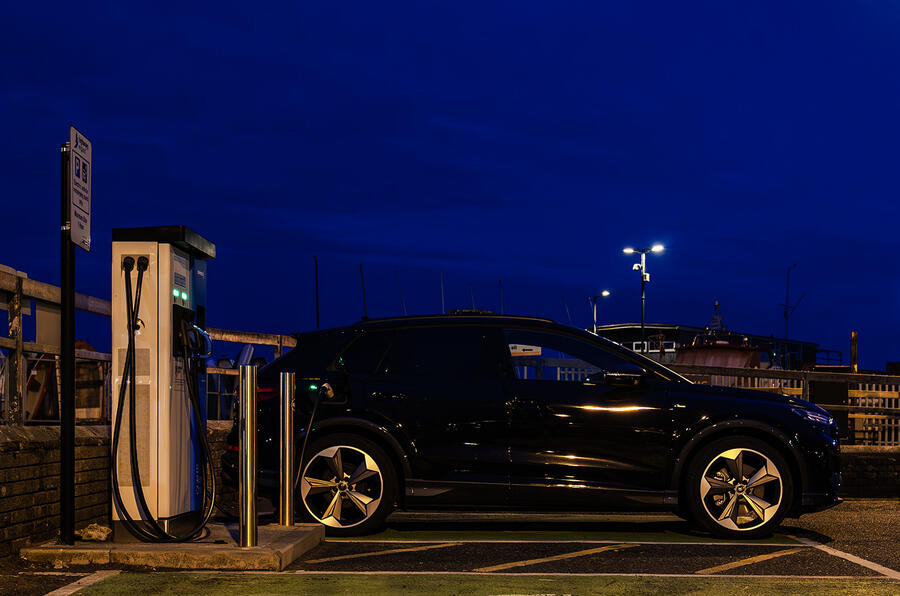
Myth #7: Paying for charging is a hassle
Okay, so you’ve parked up at a charger and you’re ready to plug in and go. How do you pay? Well, there are a lot of charging points from a lot of different providers, and in the past that meant carrying around a batch of different account cards and apps for different charging providers – sort of like having a stack of different credit cards for each and every supermarket or convenience store that you use.
Well, that’s where the UK Government’s Public Charge Point Regulations of 2023 are here to help. Going forward, all charging operators will be required to provide contactless pay-as-you-go payment options, with clear transparency about pricing.Â
But it’s also where Audi is one step ahead of the problem. The Audi charging service – also available through the myAudi app[10] – gives you one-account access to 617,000 charging points across 27 European countries from a variety of charging companies, including the fast-growing ultra-rapid IONITY network.[12] You have access to three membership options: ranging from Basic pay-as-you go to Plus and Pro tiers which balance monthly fees with discounted charging rates.
Myth #8: Charging an electric car is expensive
Depending on which type and speed of public charging you use, top-up public charging can be as expensive as petrol or diesel – with pay-as-you-go rates of around 74p per kWh on the fastest ultra-rapid chargers in the UK network.[9]
One-touch multi-provider membership packages like the Audi charging service can help you control your costs. But, as any electric car owner will tell you, home charging is where the big savings come – both in time and money. After all, according to RAC Foundation research, the average UK car spends 96% of its time parked up, with 73% of that time invariably parked on a driveway at home.[13] And that’s usually overnight, when electric rates are lower.[14] So, there’s a potential time and cost benefit to charging your car when you’re not using it anyway – and it means you’ll start your next journey the next day with good range.
Obviously, the rates you will pay for your electricity will vary depending on your home energy provider, but electric car-friendly overnight tariffs will often be as little as 7p to 9p per kWh for overnight charging.[14] So, you could easily fully recharge the 77kWh battery of the Audi Q4 e-tron for as little as £5.39 to £6.93 a night. For a driver that does 7,400 miles a year – the equivalent of around 23 home charges – that could mean it costs you as little as £124 to £160 a year to charge an electric car.
So, those are all the ways in which all-electric cars like an Audi e-tron bust the biggest EV myths. But if you want to see how they bust some of the more unusual myths, we’ve tackled those too.
Learn more about the Audi e-tron range
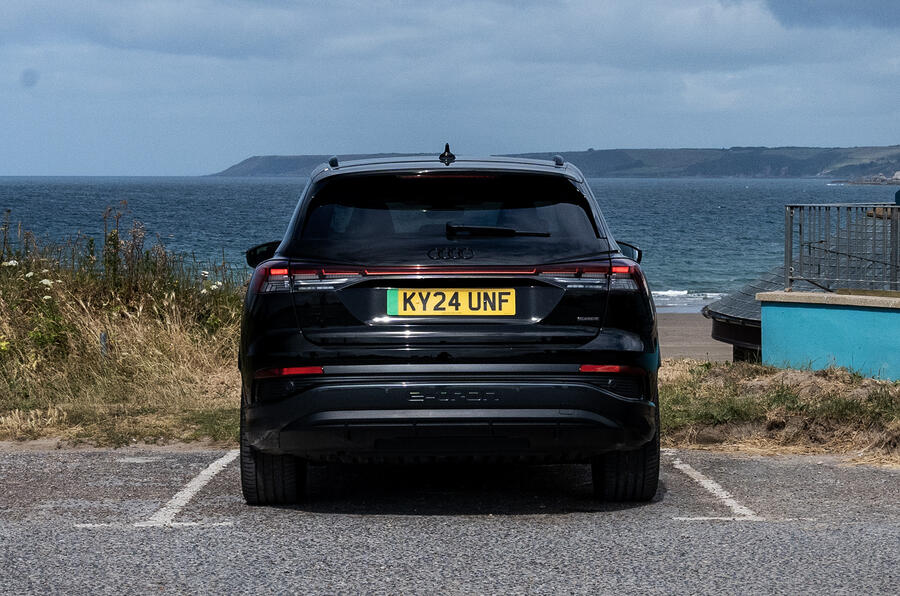
[1] Official test (WLTP) data obtained under standardised conditions after the battery had been fully charged (to 100%). The Audi Q4 e-tron, Audi Q6 e-tron and Audi Q8 e-tron are battery electric vehicles requiring mains electricity for charging. Figures shown are for comparability purposes. Only compare electric range figures with other vehicles tested to the same technical procedures. These figures may not reflect real life driving results, which will depend upon a number of factors including the starting charge of the battery, accessories fitted (post-registration), variations in weather, driving styles, route conditions, speed, vehicle and battery age and vehicle load. Data correct at August 15th 2024.
[2] The availability of 150kWh and 350kWh chargers is currently limited in the UK. They are mainly located on selected motorways and major arterial routes. These chargers are not currently available in Northern Ireland and numbers are low in Scotland, Wales and rural parts of England. Please see zapmap.com for further details.
[3] Wi-fi or mobile data connection required, data charges may apply.
[4] Source: https://www.gov.uk/government/statistical-data-sets/nts09-vehicle-mileage-and-occupancy
[5] Source: https://www.zap-map.com/ev-stats
[6] Source: https://www.zap-map.com/news/60000-public-charging-points-uk
[7] Source: https://www.rac.co.uk/drive/electric-cars/choosing/road-to-electric
[8] Estimated charging times for the standard specification Audi Q4 e-tron and Audi Q6 e-tron. Test data obtained under standardised conditions for comparison purposes. Actual charging times will vary depending on various factors, including the selected trimline (and battery option, if available), the options you choose, the type of charger used, the level of charge in the battery, the age, type, condition and temperature of the charger and the battery, the power supply to and usage of the charger, ambient temperature at the point of use and other environmental factors. Charging time will be longer in cold weather. Charging times will also be affected by the charging curve (for example, once charging passes 80%, charging will slow to protect the battery's longevity) and will be longer if battery temperature activates safeguarding technology. Please consult your retailer for further information. Data correct as at August 15th 2024.
[9] Source: https://ionity.eu/en/network/access-and-payment
[10] Compatible smartphone, app download & registration & Bluetooth connection required.
[12] Source: https://www.audi.co.uk/uk/web/en/electric/charging/audi-charging-service.html
[13] Source: https://www.racfoundation.org/wp-content/uploads/standing-still-Nagler-June-2021.pdf
[14] Source: https://www.moneysavingexpert.com/utilities/ev-energy-tariffs. Rates will depend on your tariff. Individual tariffs and off-peak hours may vary. Please consult your electricity supplier.
